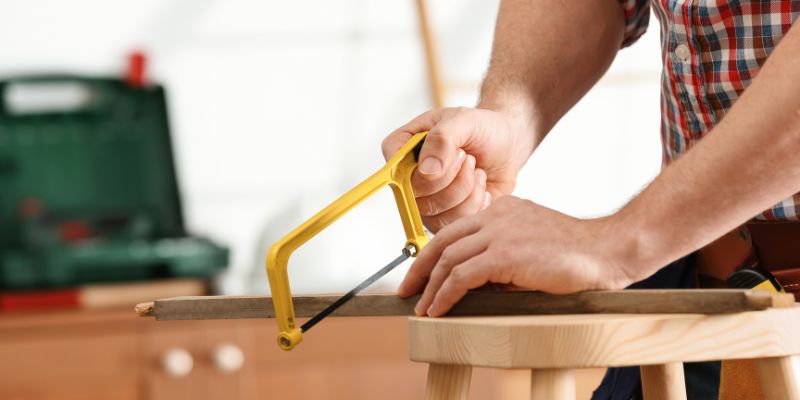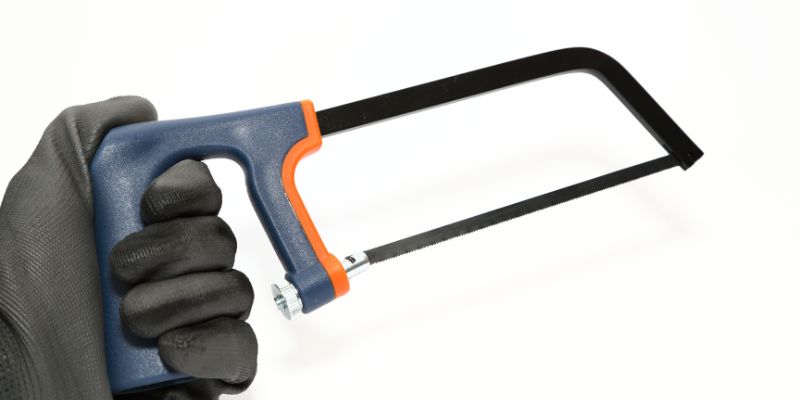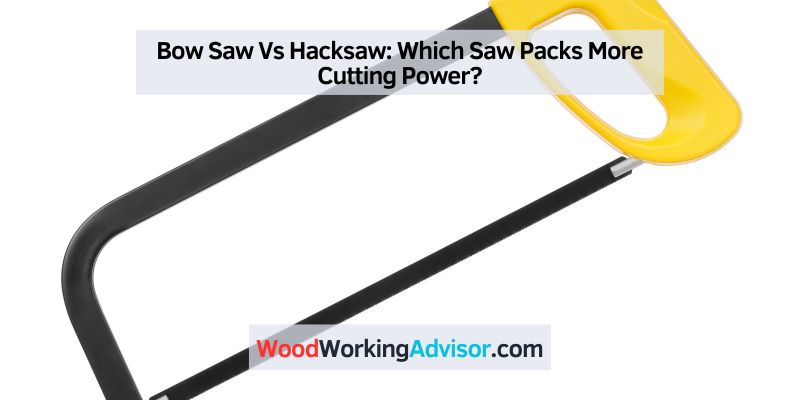The primary distinction between a bow saw and a hacksaw is their design, with the former featuring a flexible blade attached to a frame, while the latter has a rigid blade connected to a handle. Bow saws are ideal for cutting larger branches or logs, while hacksaws are specifically designed for cutting through metal.
Both tools offer their own advantages and are suitable for different applications.
Bow Saw
A bow saw is a versatile cutting tool that has been used for centuries. Its distinctive shape and design make it suitable for various cutting tasks, whether you are a professional woodworker or a DIY enthusiast. In this section, we will explore the design and features, suitable materials for cutting, as well as the strengths and weaknesses of a bow saw.

Design And Features
The design of a bow saw is simple yet effective. It consists of a long, narrow blade with teeth, attached to a framework in the shape of a bow. The bow provides tension to the blade, keeping it taut and allowing for efficient cutting. The blade is typically replaceable, making it easy to switch out when it becomes dull or damaged.
One of the notable features of a bow saw is its lightweight and portable nature. It is designed to be easily carried and maneuvered, making it an ideal tool for outdoor projects or situations where a power source may not be readily available. Additionally, the bow saw’s compact size allows for cutting in tight spaces that might be challenging for other saws.
Suitable Materials For Cutting
The bow saw is specifically designed for cutting through wood, making it a go-to tool for various woodworking projects. Whether you need to fell small trees, prune branches, or shape wood for construction, a bow saw can handle the task with ease. It is particularly effective for cross-cutting and rip-cutting through both softwoods and hardwoods, thanks to its sharp blade and design.
Moreover, the bow saw can also be used to cut through other materials such as plastic or bone, though its primary purpose and optimal performance are seen when tackling wood-based projects.
Strengths And Weaknesses
| Strengths | Weaknesses |
|---|---|
|
|
Despite its limitations, the bow saw remains a popular choice among woodworkers and outdoor enthusiasts due to its versatility, portability, and overall effectiveness in cutting through wood materials. Whether you are embarking on a small DIY project or need a reliable tool for outdoor maintenance, a bow saw should not be overlooked.
Hacksaw
When comparing a bow saw and a hacksaw, it’s essential to note that a hacksaw is best for cutting metal while a bow saw is designed for cutting wood. Each tool has distinct purposes and should be used accordingly. Consider the material you are working with before making a selection.
Design And Features
A hacksaw is a versatile and widely-used cutting tool with a distinctive design that sets it apart from other saw types. It consists of a frame that holds a removable blade under tension, allowing for precise and controlled cutting. The frame is designed to have a handle at one end, providing a comfortable grip for the user. The blade is typically thin and has fine teeth, allowing for smooth and efficient cutting through various materials. This design feature makes the hacksaw ideal for making detailed, intricate cuts, especially in metalworking and plumbing applications.
Suitable Materials For Cutting
When it comes to choosing the right saw for the job, it is essential to consider the type of material you will be cutting. Hacksaws are primarily designed for cutting through metal and plastic materials. Their fine teeth and smaller blade size enable them to effortlessly cut through materials like steel, aluminum, copper, and PVC pipes. This makes hacksaws a popular choice among DIY enthusiasts, plumbers, electricians, and metalworkers who often need to work with these materials. However, due to its smaller blade size and fine teeth, a hacksaw may not be suitable for cutting larger or thicker materials.
Strengths And Weaknesses
Just like any other tool, hacksaws have their strengths and weaknesses. Let’s take a closer look at what makes the hacksaw stand out:
Strengths:
– Precision cutting: The fine teeth on a hacksaw blade allow for highly precise and clean cuts, making it an excellent choice for intricate tasks.
– Versatility: Hacksaws can be used on a wide range of materials, including metal and plastic, making them a versatile tool for various applications.
– Compact and portable: The compact size of hacksaws makes them easy to carry and maneuver, allowing for flexibility in confined workspaces.
Weaknesses:
– Limited cutting capacity: Due to their smaller blade size, hacksaws may not be suitable for cutting larger or thicker materials, which require a more robust saw.
– Slow cutting speed: Hacksaws are not the fastest cutting tools available, as their fine teeth require patience and a steady hand to achieve the desired results.
– Blade replacement: While hacksaw blades are easily replaceable, their longevity can be affected by the materials being cut, requiring frequent replacements.
In conclusion, the hacksaw’s unique design, suitable materials for cutting, as well as its strengths and weaknesses, make it a reliable tool for precise and detailed cutting tasks on various materials. However, it’s important to consider the specific requirements of your project to ensure you choose the right saw for the job.

Comparison
When it comes to cutting tools, the bow saw and hacksaw are two popular choices that offer distinct advantages. In this comparison, we’ll delve into the key factors that matter when choosing between these two saws. So, let’s explore the cutting power and efficiency, versatility and ease of use, strength and durability, as well as the cost and availability of both these tools.
1. Cutting Power And Efficiency
When it comes to cutting power, both the bow saw and hacksaw have their strengths. However, the bow saw takes the lead here. Its long, sturdy frame, equipped with a narrow blade, allows for more power and efficiency. This makes the bow saw ideal for cutting through larger branches, logs, and even small trees. On the other hand, the hacksaw relies on its fine-toothed blade, designed for precision cutting of various materials, such as metals, plastics, and pipes. So, depending on what you need to cut, the bow saw or hacksaw will deliver different levels of cutting power and efficiency.
2. Versatility And Ease Of Use
When it comes to versatility, the hacksaw has the upper hand. Its compact size and ability to accommodate different types of blades, including fine-toothed, coarse-toothed, and even diamond-edged blades, make it suitable for a wide range of cutting tasks. Additionally, the hacksaw’s adjustable frame allows for cutting in tight or hard-to-reach spaces. On the other hand, while the bow saw may lack the same level of versatility, it compensates with its ease of use. The bow saw’s wide handle and firm grip enable users to apply force without straining their hand and arm muscles. So, whether you prioritize versatility or user-friendly operation, the hacksaw and bow saw each offer their own advantages.
3. Strength And Durability
If strength and durability are your top priorities, then the bow saw should be your go-to choice. Its sturdy frame, often made of steel or aluminum, ensures that the saw can withstand heavy-duty cutting tasks without bending or breaking. The hacksaw, while designed for lighter applications, may not have the same level of strength and durability as the bow saw. Its frame, usually constructed from steel or cast aluminum, may be susceptible to wear and tear over time. So, if you require a saw that can endure demanding cutting projects, the bow saw is the way to go.
4. Cost And Availability
The cost and availability of both the bow saw and hacksaw largely depend on your location and the specific brand or model you’re considering. However, in general, hacksaws tend to be more affordable and widely available in hardware stores and online. This is due to their compact design and their popularity in DIY projects. On the other hand, bow saws are relatively less common and, therefore, may have a higher price tag and limited availability. So, if you’re on a tight budget or in need of a saw that you can easily find, the hacksaw is likely the more cost-effective and accessible option.
In conclusion, the choice between a bow saw and hacksaw ultimately boils down to your specific cutting needs and priorities. While the bow saw offers superior cutting power, the hacksaw reigns in terms of versatility. When it comes to strength and durability, the bow saw comes out on top, but the hacksaw wins in terms of affordability and availability. So, carefully consider these factors to make the right decision and ensure that you have the perfect cutting tool for your upcoming projects.
Frequently Asked Questions For Bow Saw Vs Hacksaw
What Is A Bow Saw Good For?
A bow saw is great for cutting through branches, logs, and small trees with ease. Its sturdy frame and sharp blade make it ideal for outdoor tasks like pruning, trimming, and firewood preparation. Its compact size and lightweight design make it portable and convenient to use.
What Is The Difference Between A Bow Saw And A Hand Saw?
A bow saw is a larger saw with a curved frame and a coarse blade for cutting branches in gardening. A hand saw is a smaller saw with a straight blade for cutting wood or other materials by hand. The main difference is their size and purpose.
What Can A Hacksaw Not Cut?
A hacksaw cannot cut certain materials like dense metals or hard materials like stone and concrete.
How Thick Can A Bow Saw Cut?
A bow saw can typically cut through wood up to 4 inches thick.
Conclusion
To sum up, both the bow saw and hacksaw offer their own unique advantages for various cutting tasks. The bow saw’s versatility and aggressive teeth make it ideal for tackling larger branches and logs. On the other hand, the hacksaw’s compact design and fine-toothed blade excel at precision cutting in tight spaces.
Ultimately, the choice between the two depends on the specific project and your personal preferences. Consider the task at hand, the material to be cut, and your comfort level with each tool to make an informed decision. Happy sawing!


